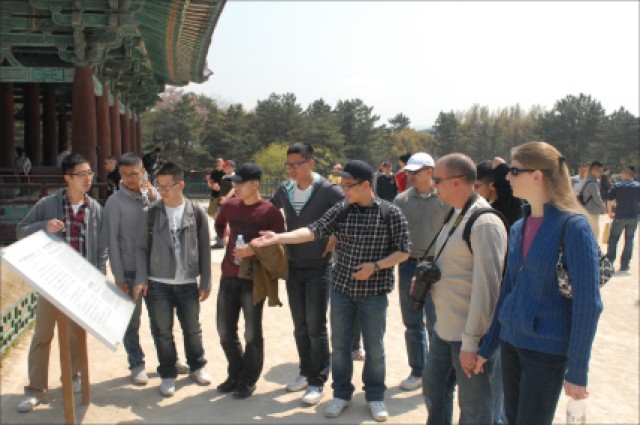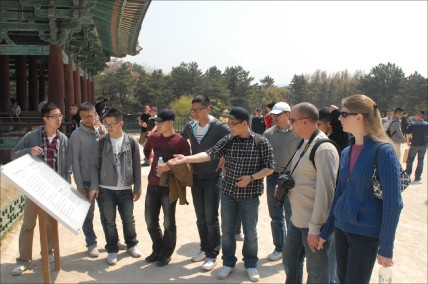DAEGU, South Korea - The United States Army Garrison-Daegu organized a Gyeongju city tour for Area IV Soldiers April 20. The tour offered a break from the KATUSA Friendship Week, April 18-22.
More than 400 Soldiers from the Daegu and Waegwan areas visited some of Korea's most historic sites within Gyeongju, the capital of Korea's ancient kingdom Silla during the period of three kingdoms.
The tour started at the Gyeongju Museum, where American Soldiers and KATUSAs broke off in several groups and learned about the Silla Dynasty through artifact and picture displays. KATUSAs led the tour, explaining to American Soldiers what each artifact signified and how Silla prospered and dominated during the period of the three kingdoms.
"Although I am a Korean citizen, I have never been to Gyeongju before. I enjoyed learning about Korean history and explaining the history to my American counterparts," said Pvt. Yun Seung-bae, 19th Expeditionary Sustainment Command G-3. "I am really happy that I came on this trip. I plan on visiting and learning about more Korean historic sites in the future."
After touring the Gyeongju Museum, the group headed over to Anapji, an artificial pond surrounded by buildings that the king of Silla used for important guest receptions.
Anapji is famous for its cherry blossom trees and beautiful natural scenery that surrounds the ancient buildings.
"I never knew Korea was so beautiful," said Sgt. Michael Gary, 19th ESC G-1. "I'm learning a lot about Korea with the help of my KATUSA friends."
Cheomseongdae, an ancient astronomical observatory, was the next place on the tourists' agenda. Constructed under orders from Queen Seonduk, Cheomseongdae is the oldest surviving observatory in East Asia and one of the oldest scientific installations on Earth.
"I was surprised by the scientific secrets behind the construction of Cheomseongdae," said Pfc. Moon In-woo, 19th ESC Supply section. "It is really fascinating to learn that my ancestors were so science-savvy and that Korea was able to preserve such artifacts until this day."
The tour ended with the group moving to Yangdong Folk Village, a traditional village where local citizens preserve the lifestyle of their ancestors.
Soldiers were able to try traditional Korean dishes, such as rice cakes. They experienced the lifestyle of Korea by walking through the village and interacting with people. Soldiers were also able to purchase tradtional Korean souvenirs.
Throughout the tour Soldiers interacted and took pictures with the local citizens and other Korean tourists on site. Korean citizens and tourists greeted the visting Soldiers with English phrases.
The day ended with Soldiers reporting back to their respective units and sharing stories of the trip with fellow battle buddies.




Social Sharing